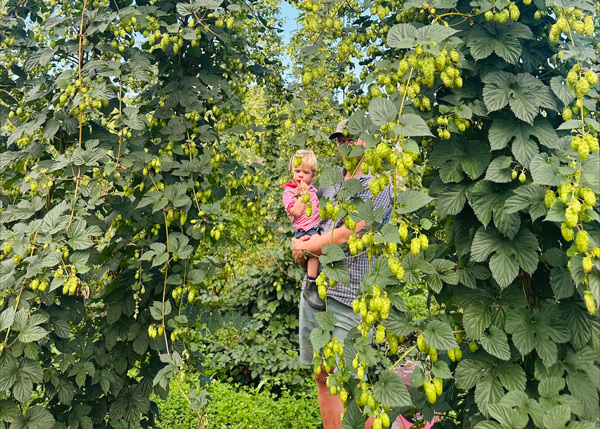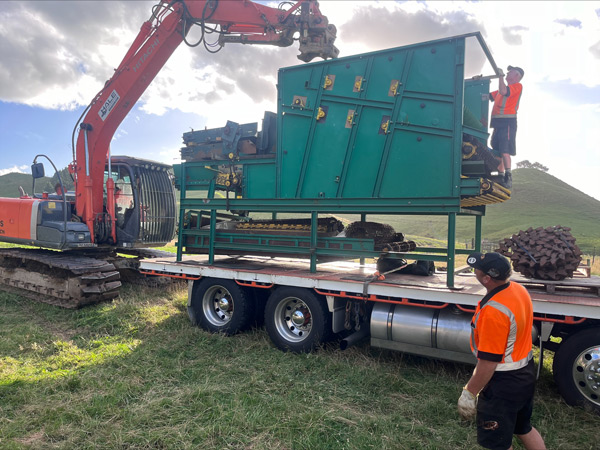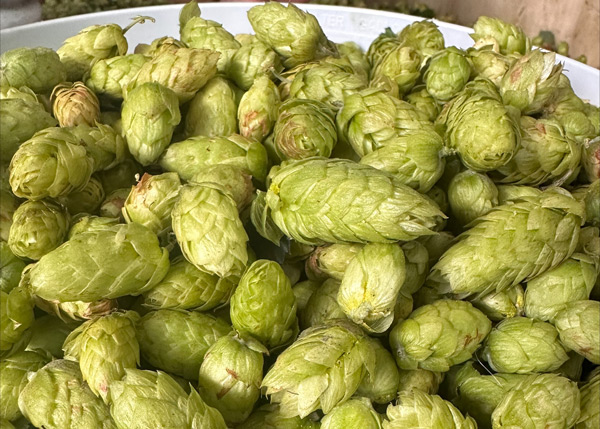From Paddock to Pint: Wayward Hops and the Potential of Land Diversification in Taranaki
Taranaki hops grower, Wayward Hops, was established in 2022 by Tim and Maggie Verry after a conversation with a close friend and brewer. Now, three years in, the project offers a unique insight into land diversification, hard work, and potential rewards of such a venture.
Wayward Hops in Tarata is one of two Taranaki growers working with the Branching Out project to scale beyond their 0.1-hectare trial plots, the other being Quarter Acre Hops in Tikorangi. The Branching Out project, an initiative of Te Puna Umanga Venture Taranaki, the regional development agency, is exploring a range of land and value chain diversification ventures and is an integral part of Tapuae Roa, the region’s economic development strategy, to build sustainable, high-value food and fibre sector.
As part of this work, Venture Taranaki published a detailed Industry Paper last year for small and independent hop growers offering guidance to emerging growers, with input from across the sector. The paper explores paths to-market, infrastructure needs, and long-term potential for hop production in the region and beyond.
Wayward Hops started their hops journey with 800 plants and lot of enthusiasm in 2022.
“From trellising to training the bines, and all the little things in between, that first season taught us a lot,” says Maggie Verry, founder of Wayward Hops.

Wayward Hops have well established hops, with their first plants going into the ground in 2022.
Despite being new to hops, the team quickly found their footing. Local breweries including Shining Peak and Three Sisters used their fresh Nelson Sauvin hops in seasonal brews. Such an early endorsement of their product’s potential was hugely encouraging for the growing business.
With momentum building, Wayward Hops expanded in 2023, adding another 750 plants and introducing the Riwaka variety.
As with any emerging venture, the team refined their systems as they went, balancing hop work with farm life and full-time jobs. Each season brought valuable insights, particularly around growing conditions and timing.
“Every year we continue to make improvements,” Verry says. “We’ve invested in harvest machinery and post-harvest tools, and have started to tailor our growing methods to suit our land and our varieties.”

The team purchased a custom-built conveyor and fan system in 2024 to support sorting and cleaning.
By 2024, the venture had grown to 1,550 plants over 0.6 hectares, with upgraded equipment helping streamline the harvest. A custom-built conveyor and fan system helped sort and clean the hops more efficiently, allowing for a faster turnaround and higher-quality output.
“The results were really encouraging, particularly our Nelson Sauvin hops, which were strong in both yield and quality. We’re really proud of what we delivered to local brewers.”
However, there are still areas to refine. Infrastructure to support consistent drying and palletising remains a priority for the coming season, particularly as interest grows from breweries beyond the region. Securing market distribution needs to be a key focus too.

Local breweries Shining Peak and Three Sisters have both used hops from Wayward Hops to produce seasonal beers.
Michelle Bauer, Branching Out Project Lead at Te Puna Umanga Venture Taranaki, says Wayward Hops’ experience captures what many landowners are navigating when looking to diversify.
“The journey of Wayward Hops is a great example of the real-world challenges and opportunities that come with land diversification,” says Bauer.
“It’s why the Branching Out project exists. Together with landowners and industry partners, we’re building the knowledge and the horticultural ecosystem to enable full value chains - from trial, to processing, to market - so growers aren’t doing this alone.”
“It’s about creating shared infrastructure, shortening supply chains, and unlocking premium product and export opportunities grounded in quality, provenance, and sustainability."
Quarter Acre Hops, the other grower in the region, has also scaled up. The team in Tikorangi now have one hectare under production, have hired a seasonal worker, and have seen impressive yields, especially from second year plants. They are similarly navigating the scaling process and consistent paths to market, but are seeing encouraging signs of commercial success.
“With our region’s strong background in agriculture, favourable growing conditions, and a practical, innovative mindset, Taranaki is well-positioned to unlock untapped potential in a range of sustainable food and fibre opportunities,” concludes Bauer.
Learn more about the Branching Out project here or sign up to the newsletter to stay up to date.

